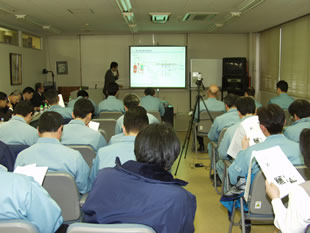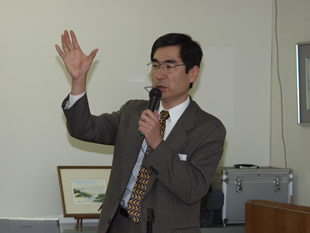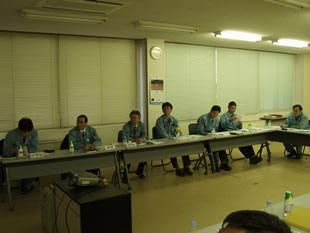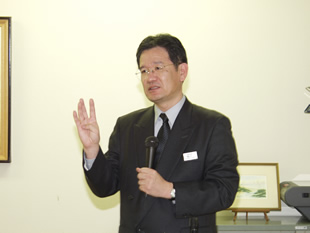|
|
 |
 On 16 Mar 2005, the 71 st Safety Caravan visit was held at JCO Co., Ltd. Tokai Plant . Located in Tokai-Village, Ibaraki Prefecture. On 16 Mar 2005, the 71 st Safety Caravan visit was held at JCO Co., Ltd. Tokai Plant . Located in Tokai-Village, Ibaraki Prefecture.
|
|

Safety Presentation |
 About 30 persons, including the employees of Tokai Plant , attended the Safety Presentation. About 30 persons, including the employees of Tokai Plant , attended the Safety Presentation.
 At the beginning of the presentation, Mr.Yoshiki Miyajima, Director, of JCO Co., Ltd. Tokai Plant , gave an address and said, “ ‘Absolutely safe and absolutely no accidents' ‘Value the fundamentals and protect them.' These are the two principles on which JCO should base all of its activities. In order to achieve this, the things we must do first and foremost is clarify the responsibilities and authority that each and every one of you holds, put an emphasis on the fundamentals and protect them. We must never forget the lessons learned from the accidents of the past and make safety our number one priority. ” At the beginning of the presentation, Mr.Yoshiki Miyajima, Director, of JCO Co., Ltd. Tokai Plant , gave an address and said, “ ‘Absolutely safe and absolutely no accidents' ‘Value the fundamentals and protect them.' These are the two principles on which JCO should base all of its activities. In order to achieve this, the things we must do first and foremost is clarify the responsibilities and authority that each and every one of you holds, put an emphasis on the fundamentals and protect them. We must never forget the lessons learned from the accidents of the past and make safety our number one priority. ”
|

|
|
Safety Presentation
|
 After the address, Mr. Machida, General Manager of NSnet, introduced NSnet activities, and this was followed by a lecture entitled After the address, Mr. Machida, General Manager of NSnet, introduced NSnet activities, and this was followed by a lecture entitled
“Future Issues and State of Affairs in the Wake of the Mihama Nuclear Power Plant Unit 3 Secondary Piping Rupture Accident ” , delivered by Mr. Khoichi Yamate, Chief Manager, Nuclear Fuel Quality and Safety Group General Office Of Nuclear Power, The Kansai Electric Power Co., Inc.
( Since the speech was delivered on March 16 th , all that could be said in regards to the state of affairs was that it was being discussed as to how to proceed. ) |

|
|
Mr.Yamate
|
 During the lecture, the mechanism which led to the Mihama Nuclear Power Plant Unit 3 piping rupture accident and the systematic inspection of all nuclear power plants that was implemented after the incident were explained along with the latest details in regards to the ongoing measurement of the thickness of the walls of all secondary piping. During the lecture, the mechanism which led to the Mihama Nuclear Power Plant Unit 3 piping rupture accident and the systematic inspection of all nuclear power plants that was implemented after the incident were explained along with the latest details in regards to the ongoing measurement of the thickness of the walls of all secondary piping.
- One thing which we must take a particular close look at is the fact that whereas “corrosion measurements were taken in cases of inadequacy,” the standards and way of thinking in regards to measuring and making judgments was distorted. )
.-• Our company, in a certain sense, had been leaving everything up to Nihon Arm and had no clear knowledge right up until the day of the accident that the piping thickness at that spot had not been measured for 28 years. You can talk all you want about “if's and “but's”, but unfortunately the fact of the matter is no one had even the faintest idea that the secondary piping could just rupture without warning.
- Our most immediate response is to take direct supervision over scheduled piping inspections and to make sure that we adequately supervise all work that is being done. In addition, I think that we must solve the problems related to education and the passing on of know-how.
.- The issues we must deal with now are the reconstruction of a quality assurance system, the prevention of labor disasters, how to continue operation of a plant that is already quite old, and rebuilding a relationship of trust with the community.
|

Safety information exchange session |

|
|
Safety information exchange session
|
|

|
|
Mr.Sakaue
|
 At the safety information exchange session, we asked Mr. Yoshimitsu Sakaue, Manager, of Safety And Health Group Administration Dept, Nuclear Fuel Industries , Ltd. Kumatori Works. to give an in-depth explanation about the good practices cited by the peer review regarding “The Promotion of Risk Assessment Activities”. At the safety information exchange session, we asked Mr. Yoshimitsu Sakaue, Manager, of Safety And Health Group Administration Dept, Nuclear Fuel Industries , Ltd. Kumatori Works. to give an in-depth explanation about the good practices cited by the peer review regarding “The Promotion of Risk Assessment Activities”.
|
The main information and opinions exchanged included:
| ● |
Whereas we have just begun to implement risk assessment activities at our plant, by how much manpower was needed to deal with the enormous 1,500 incidents at Nuclear Fuel Industries? |
| ● |
At the morning meeting held in each department approximately once a week, all the managers got together for about 10 months to deal with all the issues. About 10 to 15 minutes was given to each incident for procedure manual risk assessment. |
| ● |
Do you have any way of correcting the variation associated with risk assessment? |
| ● |
We try to be as strict as possible when assessing risk. In order to make fair assessments, we have the health and safety manager review everything and give us feedback after which is ultimately reported to the Health and Safety Committee . |


|
|
|
|







